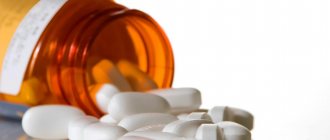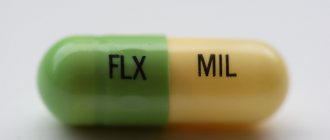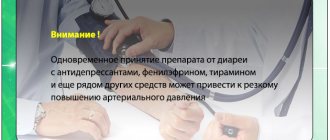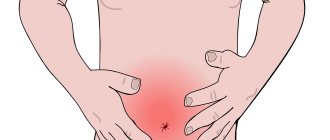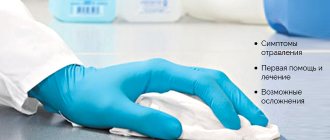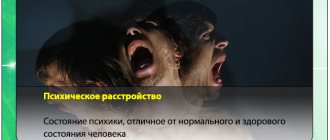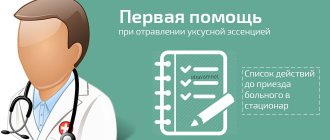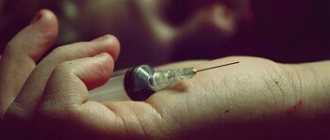Can a child be poisoned by Naphthyzin? Yes maybe. Even the simplest and safest-looking nasal drops can lead to serious consequences and harm the child’s health. Drug poisoning in children is not uncommon. Poisoning with vasoconstrictor drugs occurs especially often due to the selection and use of drugs by parents independently without a doctor’s prescription, also due to an incorrectly calculated dose of the drug and its incorrect storage.
During colds, runny nose, allergies, teething, there is a need to give drops to children. Parents use Naphthyzin because the drug has a quick effect, removes swelling of the nasal mucosa, and clears the respiratory passages.
In recent years, the number of Naphthyzin poisonings has increased. Mothers are increasingly going to the hospital with similar poisonings in their children.
How can you tell if your child is poisoned?
The following symptoms indicate that a child has been poisoned by Naphthyzin:
- Lethargy, weakness, drowsiness, and if the baby falls asleep - the inability to wake him up;
- Pale skin;
- Decrease in body temperature below normal;
- Labored breathing;
- Slow heart rate up to 40-50 beats;
- Low blood pressure.
If no measures are taken, the child may fall asleep and cannot be awakened, he may develop a coma, then cardiac arrest and death are possible.
Use of the drug Naphthyzin for children
The medicine has instant vasoconstrictor and anti-edematous effects. The main substance in the drug solution is naphazoline. The effect of the medication is based on reducing swelling of the mucous membrane and hyperemic tissues, reducing mucous discharge from the nose. The drug is available, so there is a misleading belief that it is safe. But you should follow the dosage so as not to harm the body.
Parents use the remedy for various symptoms of illness in children:
- cleansing the nasal passages for inflammatory diseases;
- elimination of nasal congestion during teething;
- allergic rhinitis;
- various runny noses.
Indeed, relief comes immediately, but even with a single use, intoxication can occur. Naphthyzin is produced in two concentrations - 0.1% solution for adults and 0.05% solution for children. Children should use the drug in the prescribed dosage no more than once every 7 hours. Often parents do not take into account the concentration of the solution, and the baby may become poisoned.
If the drug has been used repeatedly before, most likely, addiction has occurred - naphthyzine dependence.
In children, the process of addiction occurs much faster than in adults. It is important to know that the drug should not be used by children under 1 year of age, and in the future, the drug can be used only as prescribed by a doctor and strictly in the prescribed dose.
What should you do right away?
Therefore, as soon as it is discovered that the child has drunk Naphthyzin, or there is suspicion of this (for example, an empty bottle is found next to the child or the above symptoms appear), you should immediately call an emergency doctor. Over the phone, the hospital will tell parents what to do before the doctor arrives. As a rule, in this case the following measures are prescribed:
- If it is known that the child drank Naphthyzin recently, and the symptoms of poisoning have not yet developed, it is necessary to perform gastric lavage. You should first give the victim plain water or water with activated carbon to drink, then induce vomiting. After rinsing, give oral rehydration solution to prevent dehydration.
- If symptoms of intoxication appear, this means that Naphthyzin has already been absorbed into the blood. In this case, gastric lavage is ineffective and the child needs to be given water until the ambulance arrives.
It is necessary to provide comfortable conditions for the victim: lay him down or sit him down comfortably, wrap him in a blanket and keep him awake. The baby must be under constant supervision.
If the condition begins to deteriorate sharply before the doctor arrives, you should call the ambulance service again for instructions on what to do. As a rule, for bradycardia, an injection of atropine sulfate and prednisolone is prescribed; if necessary, the doctor prescribes a dopamine injection. If breathing stops, you need to do artificial ventilation of the lungs, if the heart stops - indirect massage.
In case of severe poisoning, the child is admitted to the intensive care unit. With correct treatment, after 1-3 days his condition normalizes and he is discharged home.
To prevent a child from accidentally drinking Naphthyzin in the future, it is important to store this drug (like any other medicines) out of the reach of children. After use, under no circumstances should the medicine be left near children, even for a short time. Parents should be very careful, because after playing, the baby may drink or pour medicine into his nose out of curiosity, repeating the actions of an adult.
The wide distribution of “Naphthyzin” is due to its instant action. After instillation, narrowing of the nasal vessels occurs, elimination of hyperemia, swelling, and exudation of the mucous membrane. The patient feels an improvement after 30 minutes.
Instructions for use
Nazivin nasal solution is intended for the treatment of the following diseases:
- Coryza
- Allergic reactions
- Vasomotor rhinitis
- Otitis, eustachitis (used to improve the outflow of mucus from the adnexal cavities)
Nazivin is also used as a mucosal restorative before diagnostic procedures in the nasal cavity.
The drug is contraindicated for use in the treatment of patients with the following pathologies:
- High sensitivity to oxymetazoline or additional substances in the drops
- Angle-closure glaucoma
- Atrophic rhinitis
- Disorders of the cardiovascular system
Nazivin 0.05% should not be instilled into the nose of children under 6 years of age. And the drug 0.025% is not used in the treatment of babies under one year old. Drops should be prescribed with caution to people with diabetes, thyroid problems, pheochromocytoma, and hypertension.
During pregnancy, Nazivin can be prescribed only if absolutely necessary. But during use, a woman must strictly adhere to the prescribed dosage. Patients aged 6 years and older are prescribed Nazivin 0.05%. Depending on the age and complexity of the disease, the doctor may recommend putting 1 or 2 drops into the nose. The number of applications per day can vary from 2 to 3 times.
Features of taking Naphthyzin
Uncontrolled use of Naphthyzin is a common phenomenon. Low cost and over-the-counter sales in pharmacies contribute to an increase in the number of people using drops.
With a common runny nose, many parents are in no hurry to seek medical help, independently determining the medicine, as well as the dosage regimen. The consequence of this can be severe poisoning and, in some cases, death. Drinking 10 ml of a 0.1% solution is considered a lethal dose for a child. It should be remembered that all medications are potentially dangerous if combined and dosed incorrectly.
Review of antidotes
There is no such thing as an antidote for Naphthyzin in official medicine. Treatment of intoxication is carried out in accordance with the symptoms. Unofficially, Atropine and its analogues are considered such; they can be considered antidotes at this stage. With their help, bradycardia caused by poisoning is eliminated.
In case of a serious threat of death, Dopamine can be used as an antidote. Hormonal drugs are not recommended for the treatment of children; this is an extreme measure aimed at saving the patient’s life.
If the poisoning is not very severe, the following medications can be used:
- "Enterosgel". This drug is used to treat adults and children as a detoxification agent. The daily dose for children is 22.5 grams;
- "Polysorb". The medicine is intended for the treatment of intoxications of various etiologies.
The choice of medication and the period of therapy remains with the attending physician, who bases the choice on the test results.
Stages of poisoning and their signs
In case of an overdose of Naphthyzin in children, there are 3 stages of poisoning, which have their own characteristics:
- Easy. An unreasonably frivolous attitude towards the use of Naphthyzin does not allow parents to suspect that it is the cause of the deterioration of the child’s condition. This is the main danger. The first symptoms of an overdose of Naphthyzin in children are taken as manifestations of the disease, and the use of drops continues. Children fall asleep, and the duration of sleep exceeds usual. There is weakness, lethargy, pale skin, a sharp decrease in appetite, and slight bradycardia. Hospitalization in this case is not required. Unpleasant symptoms disappear after complete withdrawal of the drug.
- Average. Requires the intervention of medical professionals to avoid deterioration of vital signs. The body is covered in cold sweat, and the temperature drops to 36 degrees and below. The child’s heartbeat is disrupted, blood pressure drops, the pupils narrow, but continue to react to light. There is a complete refusal to eat, nausea, vomiting, and convulsions.
- Heavy. With this form of overdose, depression of the central nervous system occurs. Against the background of respiratory and cardiovascular failure, pulmonary edema develops, and the child falls into a coma. Pulse and pressure drop to critical levels, cyanosis appears in some areas of the skin, and numbness of the limbs is noted. There are pauses in the work of the heart lasting more than 2 seconds. In the absence of urgent measures, there is a high probability of developing irreversible consequences for the body. If the child is in serious condition, the emergency team will take him to the nearest intensive care unit. Currently, fatal cases of Naphthyzin overdose have been reported among children who accidentally drank the drug from bottles.
Each child is individual, so others may be present in addition to the symptoms described above. If any signs of intoxication are detected, you should immediately seek medical help. Refusal to hospitalize is unacceptable.
How dangerous is the drug?
Modern doctors do not like Naphthyzin too much and consider it a frankly outdated medicine. This medicine is inexpensive and often becomes the drug of choice in the treatment of runny nose in children and adults, but it is dangerous:
- High risk of developing rebound syndrome. Naphthyzin has vasoconstrictor properties - when instilled into the nose, it copes well with a runny nose, relieving swelling of the mucous membranes. However, 2-3 hours after use, swelling may become more pronounced (stronger than it was before treatment). This is a rebound.
- Development of addiction. After just a week of regular use, Naphthyzin can cause serious drug-induced rhinitis.
- Overdose. The medicine has a rather inconvenient packaging, so even when instilled into the nose, you can easily exceed the recommended dosage (especially when treating children who are fidgety and do not really want to be treated). This is fraught with the development of unpleasant and even life-threatening symptoms.
- Poisoning. Children can drink Naphthyzin, and it will not require any extra effort from them (which is again explained by the inconvenient packaging).
Naphthyzin can be easily absorbed into the patient’s blood in the mucous membranes of the nasal cavity, while affecting certain parts of the brain, which can inhibit the activity of all life support systems. In addition, such drops affect vascular tone.
What happens if you drink?
With dosed instillation of Naphthyzin into the nose, only an overdose can occur, which rarely poses a danger to life. But if you take the medicine, the consequences will be much more dire - poisoning will occur.
Excessive ingestion of Naphthyzin into the body is dangerous due to disturbances in vascular tone, a sharp drop in blood pressure, disturbances in the functioning of the heart, and even a slowdown in its contractions. The child may become faint and even die.
First aid
In all cases, after an overdose, you must stop taking Naphthyzin, call an ambulance and monitor the child’s condition. Self-treatment of poisoning can lead to serious consequences. The decision on hospitalization is made only by the doctor.
When providing first aid for an overdose of Naphthyzin in children, it is important to correctly assess the general condition, measure the pulse and temperature. All indicators should be recorded. The victim should not be left unattended. The child must remain conscious until the ambulance arrives; for this it is necessary to constantly talk with the victim. He should be placed on the bed, covered with a warm blanket and calmed down. Milk should not be given. It will facilitate faster penetration of the product into the circulatory system.
In what cases are vasoconstrictor nasal drops used?
Vasoconstrictor drops or sprays are prescribed to treat certain diseases of the nose and ears. Just like that, for any runny nose, you shouldn’t use them
neither in children nor in adults.
They are available in the form of drops or spray. They need to be instilled into both nostrils. The dosage, frequency and duration of treatment are discussed with the treating doctor.
Remember that a therapist or otolaryngologist should prescribe vasoconstrictor drugs. It is very dangerous to use them on your own; they can cause the development of chronic rhinitis, atrophy of the nasal mucosa, or drug poisoning.
Indications for the use of vasoconstrictor nasal drops:
- Otitis media is an inflammation of the middle parts of the ear. Drops accelerate the removal of inflammation and swelling from the internal structures of the ear;
- Eustachitis is an inflammation of the auditory Eustachian tube, in which the flow of air into the structures of the middle ear is disrupted. This disease is almost always accompanied by severe hearing loss. Vasoconstrictor medications relieve swelling and relieve ear congestion
. - Difficulty in nasal breathing due to inflammatory bacterial or viral diseases accompanied by a runny nose.
Overdose when taking medication orally
Treatment for an overdose of Naphthyzin in children as a result of its ingestion should begin with gastric lavage. To do this, the child should drink several glasses of warm water and provoke vomiting, irritating the root of the tongue. It is strictly forbidden to use potassium permanganate. The procedure is repeated several times, and only if the child is conscious. Upon completion of washing, you should take sorbent agents, for example, activated carbon at the rate of 1 tablet per 10 kilograms of weight. Inducing vomiting is useless if more than 30 minutes have passed since ingestion.
In case of loss of consciousness, it is necessary to monitor the pulse and breathing before the ambulance arrives. When they are stopped, the only way to save life is chest compressions and artificial ventilation.
How to protect your baby from dangerous nasal drops
The basic rule is to comply with the requirements for age, quantity and frequency of use of the drug specified in the annotation for the drug. Try not to buy sprays containing naphazoline, xylometazoline and oxymetazoline at the pharmacy. Remember that vasoconstrictor drops do not treat a runny nose, but only facilitate nasal breathing when the mucous membrane is swollen. This is usually observed in the first 1-3 days of a viral infection. Before instilling an adrenergic agonist, you need to clear the nasal passages of mucus using a saline solution or sea water and a suction bulb. Perhaps this procedure will be enough to make the child’s nose “breathe.”
According to Life, well-known pharmaceutical companies and Roszdravnadzor bombarded Russian pediatricians with warnings in 2016–2017. Their content is approximately the same: children are increasingly being poisoned by vasoconstrictor drops. We are talking about naphthyzin, sanorin, otrivin and other similar drugs. If you overdo it with treatment, the child may get heart problems or even fall into a coma. As Roszdravnadzor notes, many parents do not know this and therefore allow their children to bury them uncontrollably. As a result, thousands of children across the country end up in hospitals every year.
At the beginning of 2017, one-year-old Seryozha from the city of Tchaikovsky, Perm Territory, caught a cold, and his mother, leaving for work, instructed his grandmother how to treat the baby. And although the boy sniffed, his mother did not leave any drops. The grandmother decided that this was not a problem and gave her grandson naphthyzin. She didn’t even drip it, but, one might say, poured it in, so as not to give the snot a chance. That day Vanya fell asleep earlier than usual after lunch.
Grandma woke him up and dropped more drops. After which the child slept all day.
The mother, returning from work, could not wake up her son. In a panic, she called an ambulance. The arriving team tried in every possible way to bring the child to his senses. With a normal heart rate of about 110–120 beats per minute, Serezha’s heart beat at a speed of only 30 beats. The boy was pale and reacted only to strong painful stimuli. At the hospital they said: naphthyzine poisoning.
The doctors managed to save Seryozha, a day later he was already running around the department, and four days later he was discharged home. The fact that the boy almost died was not the fault of the drops, but of the adults who used them incorrectly.
How the drops work
During flu and colds, our nose becomes blocked because the mucous membrane in the nasal sinuses swells and “swells.” To relieve swelling, millions of our compatriots use naphthyzine-type drops. They constrict the vessels of the mucous membrane, the swelling subsides, and the nasal passages expand.
Sanorin, naphthyzin, xylene, rhinostop are drugs of the same pharmacological group,” explains pediatrician, candidate of medical sciences Tuyara Zakharova.
The problem is that with an overdose, not only the capillaries in the nose begin to narrow. The effect extends to large vessels carrying blood to the kidneys, heart and brain. This is fraught with dangerous consequences: a person’s pulse drops, blood pressure rises, and signs of anemia appear. The adult body is able to “swallow” large doses of drops without serious consequences. But for children, an overdose is extremely dangerous. The worst thing that can happen is heart problems.
For example, sanorin is used only from the age of two, says Tuyara Zakharova. “This is due to the fact that in young children, even a small amount of the drug can cause a spasm in the heart muscle.
Drug poisoning
Roszdravnadzor sounded the alarm and from June 2016 to May 2017 sent 12 official letters to all regional medical institutions about the dangers of using vasoconstrictors. Life has copies of them at its disposal. These documents are ordered to be distributed in all pharmacies and among pediatricians. The letters mention nine names of drops. This is almost the entire “vasoconstrictor” range of Russian pharmacies.
Analyzing information about the side effects [of vasoconstrictor drops and sprays], Roszdravnadzor specialists learned about a significant number of overdoses in pediatric practice, the department’s documents say. — We have recorded a large number of acute and subacute drug poisonings in children under 15 years of age [after using the drugs].
A source in the department told Life that they began to study the problem after reports from children's hospitals in the central region.
We received data from one of the children's hospitals. In their toxicology department, over two years, 892 children under the age of 15 were treated due to [vasoconstrictor] poisonings,” a source told Life. — All poisonings were accidental and occurred due to excess dosages, as well as due to non-compliance with age-related contraindications. However, the documents do not indicate how many children in Russia were poisoned by the drops.
Life sent a request to Roszdravnadzor asking for statistics, but has not yet received a response. The scale of the problem can be assessed using the example of a specific Moscow hospital. Every year, due to improper treatment, only the hospital named after. N.F. Filatova receives 250–300 children under the age of four years.
In 2020, 244 children came to us, and in 2020, 250 children were treated. Basically, in cases of poisoning, all liquid-type medications and even household chemicals are recorded. For example, these are vasoconstrictor nasal drops,” Dmitry Dolginov, head of the hospital’s toxicology department, told Life.
Parents can recognize vasoconstrictor poisoning by several basic signs.
The main sign of vasoconstrictor poisoning is changes in the nervous system. The child becomes restless or, on the contrary, inhibited,” Boris Blokhin, chief freelance pediatrician of the Moscow Department of Health, told Life. — Poisoning can be avoided if you strictly follow the recommendations written on the drugs. And understand that any medicine is not only a treatment for the child, but also the possible development of side effects.
Life sent requests to large pharmaceutical companies in Russia and Germany that produce the drops, asking them to comment on the situation. These are Moscow Endocrine and Merkle GmbH. At the time of publication, only representatives of the company, which produces Nazol drops, responded.
To ensure the correct use of drops, Bayer informed doctors and pharmacists about strict adherence to the dosage regimen, contraindications and precautions when using medications, company representative Svetlana Meleshko told Life. — Bayer carefully processes all information on cases of drug misuse, adverse events and overdoses and provides this information to regulatory authorities.
Nazivin is a popular nasal remedy with anti-edematous and vasoconstrictor effects. It is successfully used to restore breathing in patients of any age, even in children from the first days of life. However, in order to avoid undesirable consequences from taking it, it is important to strictly follow the instructions accompanying the drug, accurately calculate the dosage and consult with your doctor.
Features of treatment
Treatment of a patient poisoned by nasal drops begins with intravenous administration of atropine sulfate. Upon arrival at the medical facility, a biochemical blood test is taken from the patient to determine the degree of intoxication. An electrocardiogram is required. The course of treatment averages from 1 to 3 days. The patient is discharged after complete restoration of normal health.
Symptomatic therapy is selected depending on the clinical picture. Gastric lavage in a hospital is performed using a special gastric tube. To cleanse the blood, Polysorb or Neosmectin is prescribed. In case of severe poisoning, glucocorticosteroid hormones cannot be avoided. In most cases, the prognosis is favorable. The components of the drug are quickly eliminated from the body.
Remember, in case of an overdose of Naphthyzin in children, the symptoms and treatment of which only a doctor can accurately determine, you must call an ambulance.
Information about contraindications and side effects
The annotation for the drug specifies conditions in which Naphthyzin has contraindications for use.
Contraindications
The medicine is contraindicated in:
- arterial hypertension;
- tachycardia;
- diabetes mellitus;
- severe eye diseases;
- chronic rhinitis;
- hyperthyroidism;
- severe atherosclerosis;
- hypersensitivity to the components of the drug.
In addition, there are age restrictions for the use of this medicine:
- for a 0.1% solution – up to 18 years;
- for a 0.05% solution – up to 1 year.
Side effects
As a result of long-term use or consumption of high doses of Naphthyzin, side effects may occur:
- Deterioration of blood supply to the brain and mucous membranes, resulting in symptoms of migraine, nervousness and weakness; in school-age children, learning ability decreases; in younger children, vision may deteriorate.
- Increased blood pressure, headaches.
- Swelling and inflammation of the nasal mucosa, hyperemia, dryness, burning sensation in the nose.
- Increased heart rate (tachycardia).
- Reduced duration of action of the drug, provoking the use of higher doses and increasing the frequency of their use.
The latter effect is most common in patients who have used Naphthyzin for more than 1 week. During this time, the small blood vessels of the nasal cavity adapt to nasal drops, and Naphthyzin ceases to have a long-term effect on them as a vasoconstrictor. As a result, patients become dependent on the drug and begin to increase its dosage uncontrollably.
Interaction with alcohol
Due to the fact that the study of the actions of Naphthyzin is still ongoing, and many aspects, including interactions with other drugs and alcohol, have not been sufficiently studied, it is difficult to talk about the effect of alcohol on the effect of the drug. However, from the experience of practicing doctors, it is known that drinking alcoholic beverages can cause swelling of the nasal mucosa in patients addicted to Naphthyzin, as a result of which they have to “drip” after drinking alcohol.
Prevention of poisoning
Over the past three years, the number of Naphthyzin poisonings has increased by 30%. According to statistics, the largest number of victims was recorded in the age group from 1 to 3 years. A timely reaction from relatives and qualified medical care helps save children even if Naphthyzin is swallowed. But it is much easier to prevent poisoning than to treat its consequences. When using vasoconstrictor drops, you should adhere to the following rules:
- Treatment of nasal congestion should begin with a consultation with a doctor, who will select the optimal dosage and duration of therapy. The percentage of solution should correspond to the age of the child. Drops of 0.025 - 0.05% are acceptable for use. It is strictly forbidden to instill the product into infants. A negative reaction may occur even after a single use.
- Be sure to study the packaging, paying special attention to the expiration date. Expired product should be thrown away immediately. Parental negligence can cost a child's life. The shelf life cannot exceed 3 years from the date of production. However, it is better to play it safe and not use the drug a month before it expires.
- Increasing the dose does not affect the effectiveness of the drug, but, on the contrary, is harmful to the body.
- Read the instructions carefully. The drug should not be instilled more often than once every 6-8 hours.
- Use a pipette. Inconvenient plastic packaging often leads to excess instillation, more than 5 times. It is especially easy to miss an overdose if the child uses the medicine on his own. All manipulations should be carried out only by parents.
- Do not store Naphthyzin in places accessible to children. All medications should be placed in special cases on the top shelves.
- Alternate the product with other vasoconstrictor drops. Instead of instillation, Naphthyzin can be used as a lotion. To do this, cotton swabs are soaked in a 0.05% solution and placed in each nostril for 2 minutes.
Tips for parents
Young mothers and fathers are very susceptible to fears for the health of their child. Therefore, it is not surprising that at the slightest sneeze and barely audible sniffing, parents rush headlong to the medicine cabinet for time-tested medications. In particular, for Naphthyzin, which we ourselves literally grew up with.
But in order to prevent the child from being poisoned, thereby causing harm instead of benefit, mothers and fathers must firmly understand and remember:
- It is strictly forbidden for children under 1 year to drip Naphthyzin;
- any medications should be prescribed only by a pediatrician;
- if Naphthyzin is prescribed, strictly adhere to the indicated dosage;
- do not exceed the dose and do not increase the number of days when taking this medicine (this does not speed up recovery, but only causes addiction, which can result in drug-induced and then atrophic rhinitis);
- do not buy children Naphthyzin in a higher concentration than is appropriate for their age;
- observe the intervals between instillations of the drug;
- use a pipette;
- alternate with other drops for colds and viral diseases.
Poisoning with Naphthyzine due to an overdose caused by addiction can be avoided. But if addiction has already formed, it is quite possible to “get off” the drug; you just need to stop taking it for a few days, using other means to ease nasal breathing. Naturally, drops replacing Naphthyzin should also be prescribed by a doctor.
Be careful!
“Naphthyzin” is a toxic drug, it should be prescribed only by a doctor, and the course of treatment cannot exceed 7 days. It should be remembered that this remedy does not cure the disease, but only helps to temporarily relieve unpleasant symptoms. A dangerous side effect of the drug is rapid addiction to it. Pediatricians recommend using safer and more effective analogues to treat runny nose in children.
Recently, the problem of poisoning with vasoconstrictor drops has become relevant, as the number of incidents is constantly growing. Many parents don't even realize the danger. Therefore, doctors insist on widespread coverage of this problem in the media.
Naphthyzin poisoning is a pathological condition that occurs when the drug is used in excessive doses. Its causes include ingestion of the drug, the use of a concentrated solution, and ignorance of the pharmacodynamics. Poisoning is indicated by surges in blood pressure, bluish skin tone, and slow heartbeat. Treatment is carried out mainly in a hospital setting. But first aid to the victim should be provided immediately after the symptoms of an overdose appear.
Nazivin Sensitive: instructions
Unlike the drug Nazivin, which is available in the form of a spray for children from 6 years of age, Nazivin Sensitive can be used in the form of a spray, and not drops, from 1 year. For many parents this is very convenient, since not all children can tolerate nose drops. But they perceive the spray as a comfortable non-medicinal remedy for improving nasal breathing.
Nazivin Sensitive contains the same active ingredient - oxymetazoline. It is intended for the treatment of various types of runny nose, except atrophic rhinitis. It is also used to relieve swelling of the nasal mucosa before diagnostic procedures. Sensitive spray or drops help prevent bacterial complications of viral or inflammatory rhinitis.
As reviews from parents show, Nazivin Sensitive quickly helps children get rid of a runny nose and breathe freely through their nose. Oxymetazoline has not only antiviral and anti-inflammatory effects. It also improves the functioning of the immune system as it restores air ventilation in the nasal cavity and voids.
- Children under 1 month are prescribed Nazivin Sensitive drops 0.01%. Instill a drop of the solution twice/thrice a day.
- Children from 1 month to one year can instill 2 drops of solution. During the procedure, the child's head must be tilted back so that the medicinal liquid penetrates the nasal cavity.
- Children aged 1-6 years can use a 0.025% spray. To achieve a therapeutic effect, it is necessary to inject 1 dose of the drug.
- Adults and children over 6 years of age are recommended to inject 1 dose of Nazivin Sensitive 0.05%.
The frequency of use and dosage is prescribed by the treating ENT specialist. The drug should not be used for longer than 5-7 days. As experts' reviews show, long-term use of vasoconstrictors causes addiction to the mucous membrane.
The price of the drug Nazivin Sensitive is slightly more expensive than the nasal drug Nazivin. But their indications and contraindications are identical, since both types of vasoconstrictors have the same active ingredient. It is also important to consider that the price of the drug Nazivin may differ depending on which pharmacy chain it is sold in.
Therapeutic effect of Naphthyzin
Naphthyzin is widely in demand due to its low cost - the price for 5 ml of solution rarely exceeds 20 rubles. It eliminates nasal congestion 5-10 minutes after instillation, and the resulting effect lasts for 6 hours or more. This happens due to the ability of the active substance - naphazoline - to stimulate alpha2-adrenergic receptors.
As a result of this effect, specific signs of rhinitis disappear:
- burning, tickling and scratching in the nasal cavity;
- feeling of lack of air when inhaling;
- separation of liquid or thick secretion.
Naphthyzin stops inflammatory processes, eliminates swelling, irritation and redness of the mucous membranes. It is relatively well tolerated and provokes negative reactions from the body, usually when the dosage regimen is violated. But the appearance of side effects from Naphthyzin is often diagnosed in clinical practice. This is swelling of the nasal mucosa, atrophic rhinitis, attacks of nausea, arrhythmia, dizziness, increased blood pressure, drowsiness.
Composition and purpose of Naphthyzin
The active ingredient of the anticongestive drug, alpha-adrenergic agonist, or more simply, Naphthyzin vasoconstrictor drops, is naphazoline. The composition contains purified water and boric acid as excipients.
The medicine has vasoconstrictor properties, quickly reduces swelling of the nasal mucosa, exudation (discharge), hyperemia (redness).
The use of Naphthyzin is indicated for:
- acute colds or allergic rhinitis;
- sinusitis;
- eustachitis (inflammation of the auditory tube);
- to perform the rhinoscopy procedure.
Causes of Naphthyzin poisoning
An interesting fact is that the drug not only treats a runny nose, but also causes its development. We are talking about drug-induced rhinitis, which develops due to long-term use of Naphthyzin and nasal drops with xylometazoline (Galazolin, Xymelin). If you use them for more than a week, the body stops fighting the disease on its own. Now you need to constantly use drops up to 10-15 times a day in order not to suffer from nasal congestion. The concentration of naphazoline increases significantly - Naphthyzine poisoning occurs.
Drug-induced rhinitis is difficult to treat, especially in severe form . The patient has forgotten how to breathe without Naphthyzin and experiences physical and psychological discomfort. The active ingredient accumulates in the body, significantly worsening a person’s well-being, causing poisoning.
Due to improper use
The apparent harmlessness of the drug often becomes the cause of poisoning. A sick person does not go to see a doctor, but to a pharmacy. Having chosen Naphthyzin, he does not read the instructions, but immediately instills the solution into his nose. Often the patient repeats this 5-7 times a day, which is a dangerous violation of the dosage regimen. The instructions for use recommend administering the drug into each nasal passage for adults - 1-3 drops 3-4 times a day.
After 2-3 days of exceeding the dose, the first signs of poisoning may appear.
Causes of an overdose of nasal drops also include:
- device of a plastic bottle - instillation is done by pressing on its base. Without calculating the force, a person injects 2-3 times more solution into the nasal passage than recommended in the instructions;
- subjectivity of sensations - a person feels that the medicine does not help for a long time, and he uses it again. Even with severe rhinitis, swelling of the mucous membrane disappears after 15-20 minutes;
- using expired Naphthyzin - the nasal remedy loses its medicinal properties. Toxic chemical compounds are formed that are dangerous to the human body.
An unexpected and negative effect of treatment occurs in the presence of contraindications that the patient was not previously familiar with. This list includes hypertension, hyperthyroidism, severe atherosclerosis, and tachycardia.
Is naphthyzin harmful to children's bodies?
Adults are less sensitive to the drug than children. If two drops of the solution are dropped into the nose of an infant, he may receive naphthysine poisoning. Intoxication is possible not only when instilled into the nasal cavity, but also when drops enter the gastrointestinal tract.
The main causes of poisoning with naphthyzine drops include:
- low price of naphthyzine, which attracts buyers;
- wrong choice of medicine. Instead of a 0.05% naphthyzine solution, parents purchase 0.1% at the pharmacy;
- accidental ingestion of naphthyzine, which is in an easily accessible place;
- drops cause persistent addiction;
- production of drops in small plastic containers with a volume of 15 ml. Such packaging causes an overdose, since excessive pressure on the vial will lead to instillation of an excess dosage;
- use of the drug in children as self-medication. Drops should be prescribed by a pediatrician, taking into account individual characteristics and compatibility with other medications taken for recovery;
- Often adults do not read the instructions before instilling the drug into their baby. The insert states that the use of the drug in children under 12 months is prohibited. Ignoring this recommendation will provoke naphthyzine poisoning in children: treatment, the antidote of which will be difficult to find;
- using drops that have expired;
- allergy to the drug.
Symptoms of Naphthyzin poisoning
If you take Naphthyzin, the consequences can be extremely severe, even leading to coma. It all depends on the individual characteristics of the human body. In case of hypersensitivity to the ingredients, systemic allergic reactions develop: anaphylactic shock, Quincke's edema.
Symptoms of Naphthyzin overdose when applied topically are varied:
- a rise in blood pressure with its subsequent decrease to values dangerous to health and life;
- attacks of nausea, often ending in vomiting;
- headaches similar to migraine;
- decreased heart rate;
- pain in the epigastric region and lower abdomen.
Symptoms of a chronic overdose of Naphthyzin also include atrophic changes in the nasal mucosa, which develop gradually.
Symptoms of overdose
With a slight overdose of Naphthyzin, the child may become drowsier, weaker and visually pale. His appetite decreases, the baby does not show vital activity. If you measure your heart rate or blood pressure, you will notice that these indicators have decreased.
Unfortunately, most often manifestations of mild poisoning are mistaken by parents for typical signs of a cold. And if you continue to use Naphthyzin excessively, this will lead to more dangerous consequences.
In case of moderate poisoning, the symptoms will be more pronounced:
- The baby may become very pale.
- You may suddenly feel drowsy.
- The child completely refuses to eat.
- There is apathy.
- The heartbeat slows down significantly.
- The pressure drops.
- The temperature is decreasing.
- The pupils narrow sharply and react poorly to light.
If too much medicine enters the baby’s body (for example, by accidental ingestion), this can lead to severe depression of consciousness and even the development of coma. This condition is usually accompanied by:
- Sharp pallor of the skin until it acquires a gray-earthy color.
- Significant coldness of the extremities.
- A drop in blood pressure and heart rate.
- Lack of response to external stimuli.
At the slightest suspicion of an overdose of Naphthyzin, it is better not to hesitate and call an ambulance. To eliminate toxic effects, complete abstinence from the medication is important.
Degrees of Naphthyzin overdose
When determining therapeutic tactics in case of poisoning with a vasoconstrictor, the doctor takes into account the severity of the victim’s condition.
In clinical medicine, there are three degrees of Naphthyzin overdose:
- first. The person complains of weakness, drowsiness, dry nose and sore throat, and lack of appetite. All symptoms are reversible and disappear without a trace after discontinuation of the drug;
- second. Poisoning is manifested by nausea, shortness of breath, local allergic reactions, including urticaria. Symptomatic treatment is carried out at home;
- third. There is a systemic allergy, clouding of consciousness, tremors of the arms and legs, and breathing problems. In such cases, saving the life of the victim is possible only in the intensive care unit.
Treatment of overdose in children and pregnant women is carried out somewhat differently. They will definitely be taken to a hospital facility. In the hospital, their condition is constantly monitored by doctors and junior medical staff.
Lethal dose of Naphthyzin
The drug is not used in the treatment of rhinitis in children under one year of age. In a child under 12 months, even one drop of a 0.1% solution can cause respiratory arrest. The life-threatening dose for an adult is 150 mg. This amount is contained in approximately a small 200 ml bottle. For children in the first two years of life, 10 mg of Naphthyzin is considered a lethal dose.
Naphthyzin should be stored in a dark place at room temperature. Young children's access to it must be limited.
Main characteristics of the drug
The medication is a special solution based on naphthyzine of varying concentrations.
Thanks to this composition, the medicine has an anti-edematous and vasoconstrictor effect, which is achieved when the drug acts on the receptors of the nasal mucosa and reduces blood flow. This effect is reflected in the elimination of swelling, easier breathing, and a decrease in the production of mucus. The medicine is prescribed for both children and adult patients, is available without a prescription and has an affordable price. However, over-the-counter access and an affordable price do not mean that the drug can be used uncontrolled and for a long period, since Naphthyzin has quite a lot of adverse reactions, especially with long-term treatment. It is also necessary to take into account that prolonged use not only causes serious symptoms, but also develops addiction, which results in an almost complete absence of the desired effect.
First aid for Naphthyzin poisoning
If a child or adult drinks Naphthyzin, it is necessary to perform gastric lavage. Give the victim warm water, and then press on the root of the tongue with your fingers or a spoon, inducing vomiting. It is strictly forbidden to wash the stomach of a person who is unconscious. (vomiting will cause dangerous breathing problems).
What else can you do to provide first aid:
- lay the victim down, calm him down, cover him with a blanket;
- monitor your condition by measuring your pulse and blood pressure every half hour;
- give him sweet hot tea;
- Give any enterosorbent from your home medicine cabinet - activated carbon, Polyphepan, Polysorb, Smecta, Enterosgel.
But all these activities should be carried out only after calling the ambulance team. The doctor will assess the condition of the victim, prescribe treatment or hospitalize him.
Packaging and dosage form of the drug
The drug is offered in the form of nasal drops and spray. The different forms should be used taking into account the planned treatment.
Spray
For the convenience of carrying out medical procedures, “Nazivin” in the form of a spray is produced in bottles equipped with a sprayer. When injecting the medicine, the entire mucous membrane is irrigated, including hard-to-reach areas.
Nasal drops
Vasoconstrictor nasal drops are an almost transparent solution from colorless to pale yellow. Drops are available in tinted glass bottles with a built-in pipette cap. The bottles are packed in cardboard boxes.
Treatment of poisoning with Naphthyzin drops
Treatment of Naphthyzin poisoning begins immediately after diagnosis. When choosing medications, the doctor is guided by the age of the victim, the severity of symptoms, and the presence of chronic diseases.
There is no antidote for Naphthyzin poisoning . The following medicines may be used:
- if there is a sharp jump in blood pressure, antihypertensive drugs in the form of tablets or injections are indicated (Enap, Dibazol, Furosemide, etc.);
- to relieve bradycardia, intravenous administration of Atropine sulfate or Dopamine is practiced;
- The universal antidote for any food poisoning is activated charcoal. But recently, preference has been given to enterosorbents in the form of a suspension, for example, Enterosgel.
After normalization of the condition of the adult or child, maintenance therapy is carried out. To restore water and electrolyte balance, Regidron, Gidrovit are used, and to strengthen the body's defenses, balanced complexes of minerals and vitamins (Centrum, Vitrum, Supradin) are used.
Possible consequences
Consequences of poisoning with this drug:
- Lungs – insomnia, slight restlessness, slight dizziness.
- Moderate severity - surges in blood pressure, disruptions in the gastrointestinal tract and central nervous system.
- Severe – persistent increase in blood pressure, disruption of the respiratory system, allergic pulmonary edema, coma.
The consequences can be especially serious for children, people with weakened immune systems and elderly patients. To avoid worsening the condition, at the first signs of intoxication you should immediately consult a doctor.
Prevention and possible complications of overdose
With prompt first aid and proper treatment, the consequences of poisoning are not observed. The active ingredient is excreted from the body by being converted in the liver.
The best prevention of poisoning with nasal drops is their use as prescribed by a doctor in the dosage regimen specified by him. It is forbidden to increase the recommended dose of the drug or use it for longer than 7 days. Naphthyzin should be stored in places inaccessible to small children and people with unstable mental health. If all recommendations are followed, the risk of overdose tends to zero.
Who is at risk of poisoning?
Most often, children under three years of age are hospitalized with overdose and poisoning with Naphthyzin. This is explained by:
In addition, children with disorders of the nervous system are at risk. Naphthyzin is generally contraindicated for them, since even in a therapeutic dosage this medication can have a negative effect on the body.
Side effect
Taking medication outside of the restrictions or significantly increasing the standard dosage leads to side effects. Local reactions include dryness and a burning sensation of the mucous membrane, from the digestive system - attacks of nausea, from the central nervous system - a feeling of constant fatigue, migraines, sleep disturbances, and a feeling of anxiety.
Prolonged continuous use can provoke mucosal atrophy, tachyphylaxis and drug-induced rhinitis.
In case of a significant overdose of the drug or internal use, there is a pronounced constriction of the pupils, attacks of vomiting, an increase in temperature, an abnormal heart rate, respiratory distress, and swelling of the lungs. If there are side effects, it is recommended to consult a doctor and undergo symptomatic therapy. You should also consult a doctor if you need to treat with Nazivin for more than 5 days in a row.
